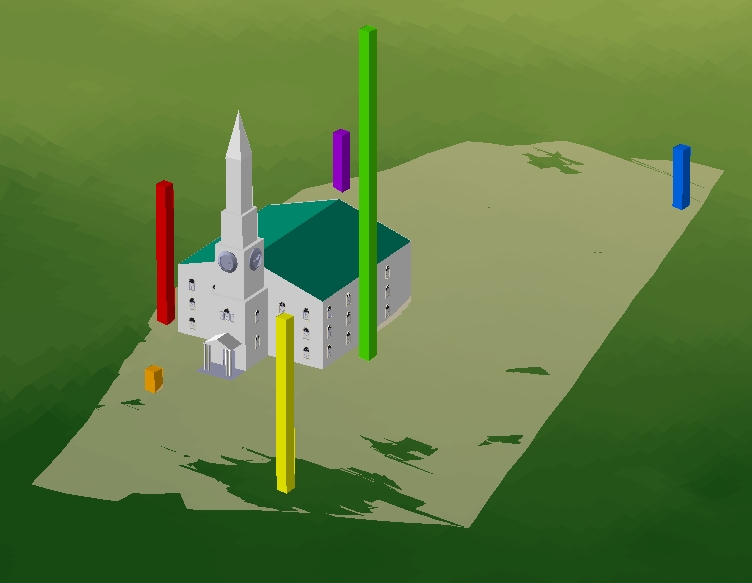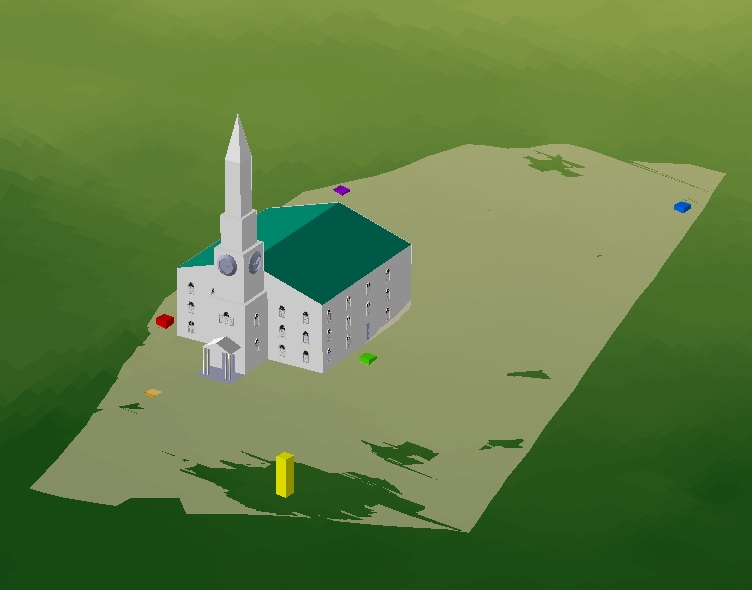September 17, 2007
Today was my first day at the FBC site, which consisted of several trenches throughout the grassy area surrounding the church. I was at trench C2, in the NE corner of the site. This trench proved quite interesting, from the numerous bulbous white roots scattered throughout the trench to a pearl to some interesting pottery chards. I have never worked with the land this way before, and I find it quite exhilarating and exciting. I am used to using the land, the soil, and nurturing it so that it can produce food and products for my own use. Never have I looked to the ground to provide information about the human past through the inspection of the soil I (we all, really) depend on. Still, it has its similarities. Both gardening/farming and excavation work give you a heightened sense of place- you notice slight changes in soil texture and color, land gradient, even if someone has thrown trash near your site since the last time you worked there. Establishing this closeness with place is something that is very important to me, and I am excited that this class is allowing me to expand the ways that I can connect with the land.
On a less serious note, digging is like fulfilling that fantasy you had as a child when you actually thought you could dig deep enough in your little sandbox to find buried treasure. I mean, I found a pearl today! That is getting close, isn't it?
September 24, 2007
Today was my second day excavating at the FBC site, and I remained at site C2 in the NE corner of the site for the duration of the day. I arrived a bit late due to a long harvesting morning, but was early enough to enjoy the mixture of sun and shade provided by site C2. I worked with Maia, who just joined the class, and we had a great time exploring the depths of the SU2 and SU3 layers of the trench. We came upon some interesting sand deposits, one that seemed to be in the shape of a lock and another that followed the entire depth of SU2. I was convinced that they would lead to something more interesting, but alas my sandbox fantasy only carries so far in the real world.
However, we did find some interesting pottery chards and a button, which were my favorite finds of the day. One chard in particular was interesting because I could see a floral design painted on it, similar to pottery I recall seeing in my grandmother's cluttered china chest (oh nostalgia for the old days.... ). Also, the button was simple but humanized the whole experience of finding just small pieces of what is a complete past; someone actually used that button for something. Somehow that is more real to me when I find a whole object.
Overall it was an outstanding day, the weather cooperated and we found some interesting things. I look forward to the digs to come!
10/1/07
The third dig and the first day of October; the weather was showing signs of fall today. Still, the sun was shining and only in the shadows of the trees did I feel uncomfortably cold. I can only imagine what it will be like in a month...
Today I was digging at a new site, D1, which is located next to the staircase on the southern side of the church. This trench is on an incline, which makes for some interesting and sometimes uncomfortable digging angles! However, this sight is full of interesting artifacts. Doug and I found around 80 nails, 150 pieces of glass, various metal pieces, pottery chards, a bead!, and a piece of mirror. It seemed every dustpan full of dirt I was dumping into my bucket had at least one or two things in it that needed marking. By the end of SU3 our bag was brimming and the task of labeling loomed ahead, yet I was incredibly excited to reexamine all of the objects.
After taking a second look at the number and type of objects, it became apparent that some type of construction was done on this side of the building that involved removing several nails (and throwing them on the ground only to be covered with grass....too) and also possibly the removal or addition of red brick. As of now I have no idea what the construction history is of the church, but it would be interesting to look at records to see if we could determine when and what was done!
I can't wait to see what comes out of D1 next week, and also to work on some other trenches!
October 15th, 2007
Today my time digging was short- but for good reason! Down the street at the Nightingale-Brown House I spent the first hour and a half of class learning about and using remote sensing equipment with a small group of my classmates. We used two different methods- one that records things that are magnetically charged (the direct method) and things that are not magnetically charged on their own but become magnetically charged when a current is sent through them (the indirect method). Both methods allow for a better picture of what is going on underneath the surface, and it was exciting to entertain all the things that might exist under the nicely manicured lawn surrounding the house...I hope to see the results sometime this semester!
Then I went over to the first Baptist Church site and worked at site D1 again. Although this site still seems to be the most fruitful in terms of volume and number of found artifacts, there were fewer items today than the last digging day. The type of items were similar- nails, glass, pottery sherds, etc. but there was definitely less to count. It seems that the trench is starting to get deep enough now, SU4 (started SU5 at the end) that we are reaching a 'time period' where there was less activity or items used were not preserved in the soil...we will have to wait until the next digging day to see if the artifact numbers keep tapering off!
October 22, 2007
Today's dig was very short, as I had to leave class early, but very exciting. I worked on the Northwest part of the Lawn at D3, which was a huge change from the trench near the stairs. Not only were there drastically fewer artifacts per soil layer at this site, there were several pedestals throughout the trench which made it difficult to dig. The unknown soil/rock/roots that are contained within the pedestals are still a mystery to all of us, and I can only hope that in the next few weeks we will be able to investigate what they could potentially be! An old garden site? Posts for an old fence?
And, of course, my obsession with finding shiny beautiful things was fulfilled by stumbling upon an old coin, from 1894, at the southeast corner of the trench. Nearly all the text was worn off and the picture was faint, but 1894 was easily visible after dusting it off a bit. (If I were a gambler...) It would be easy to take this coin as a sign that more are to come, but I know I was lucky just to find one!
November 5th, 2007
All good things must come to an end, and so ends our time excavating at the FBC site. Quite a bittersweet ending- it is getting too cold, the sun gone too soon, and the soil layers nearly sterile. Today we worked on cross sections of the trenchs, taking final measurements, and filling in the holes. Hands numb and noses running, we quickly made it through taking the measurements and cross sections. I am excited to see the final soil images- it is hard for me to comprehend the final product when all I see is lines and dots on graph paper. I will never forget the iced over gazes everyone had during this part of the day!
Then came the manual labor- remaniscent of some landscaping duties in my past- we carried dirt, dumped dirt, compacted dirt like machines. It was sad yet satisfying because even though digging is over, we now get to move on and explore and analyze the fruits of our labor. I cannot wait to get to cleaning!
November 12th, 2007
Today we cleaned all the artifacts from the dig. I have been spending a lot of time working with last years data and images for another project I am doing, and definitely thought previous to this class that last years finds were much more interesting. However, it became clear that all objects become more interesting when you see what they truly are- dirt removed- and grouped with others of a similar likeness. Then you can see pieces of ceramic fit together into a delicately painted plate, or marvel over the number of pipes found throughout the dig- these are things we are just now able to do with this years finds!
The actual process was monotonous and I hate to admit it- but my jealousy grew exponentially of those donning I-PODs throughout the class period. I need that distraction because then I forget about how tedious the work is, but I made it through, as we all did. I look forward to getting the data to work with in GIS!
November 19th, 2007
In the lab again today- but this time the focus was organizing the artifacts. Because I am doing a GIS based project, I was focused on filling in the gaps in the data, for instance where artifacts didn't have a date, SU number, or even trench ID. This turned out to be like a wild goose chase, trying to get to the dried artifacts before everyone put them in bags for analysis. Probably the most frustrating but ironic part of it all is that most of the SUs that didnt have numbers on them happened to be SUs I was working on- now I really know the importance of making sure everything is marked well!
I am excited to use GIS for the final project, but a little nervous as well. Using GIS in archeology is a very powerful tool, but few people at Brown know much about how to use GIS in the context of archaeological work. I can create very basic models, and know there must be a way to do a more sophisticated analysis of the data, but I am just not sure how to do it! Oh well- at least we will have some visuals that help anyone understand, even at a quick glance, what we found and where.
December 3rd, 2007
So for the past few weeks I have been working in the GIS lab generating images of artifact distrubution per trench and SU layer. I have generated around 100 jgegs or so, and have been using the arcScene program in GIS to generate these images in 3-D. Most of my work has been reformatting the excel data and entering in values for each bar graph for each photograph, which is easy to get lost in, but in the end I hope these visuals will make it easier to analyze where artifact concentrations are in the site. Below I will post a selection of the images I have generated thus far.
Nicole
Field Team
Home
This image shows the total number of found artifacts at each trench
 This image shows the total number of ceramic artifacts at each trench. Note: these images will have number labels soon!!!
This image shows the total number of ceramic artifacts at each trench. Note: these images will have number labels soon!!!

 Geographic Information Systems Utilization in Archaeology.doc
Geographic Information Systems Utilization in Archaeology.doc